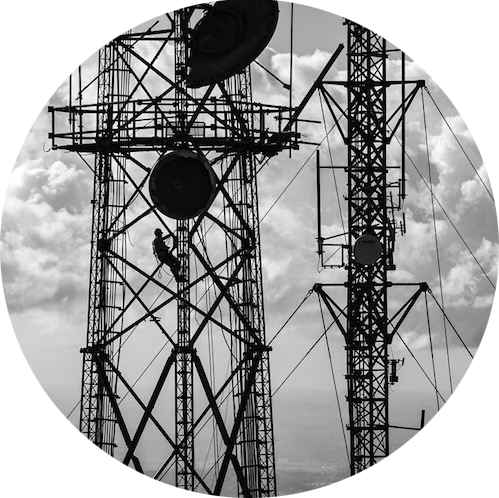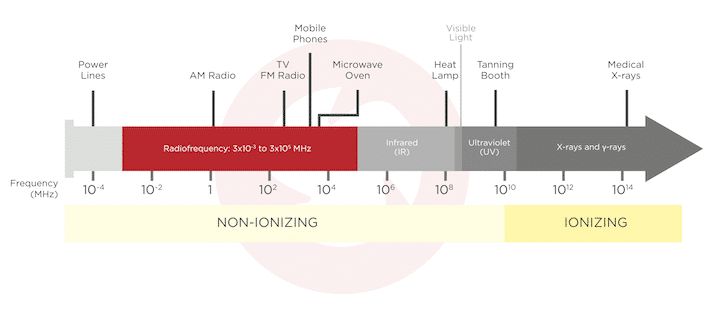Radiofrequency Radiation Profile

RADIATION – POSSIBLE CARCINOGEN (IARC 2B)
Contents
Radiofrequency Radiation Profile
General Information
Radiofrequency radiation (RF) is a type of non-ionizing radiation that consists of both electric and magnetic fields. It includes frequencies ranging from 3kHz to 300GHz, falling within a portion of the electromagnetic spectrum that is below visible light and above extremely low frequency electromagnetic fields (Figure 1).[1]
Figure 1. Radiofrequency waves fall within the non-ionizing range of the electromagnetic spectrum.[2]
RF is generated when a source current (e.g. a broadcasting transmitter) is fed to an antenna, producing energy within the antenna that moves outward in the form of an electromagnetic RF wave.[3] RF waves are used for radio transmission, carrying electromagnetic energy through free air and dense media.[2] Communication devices (e.g. radios and cellular phones and broadcast towers), medical equipment (e.g. magnetic resonance imaging (MRI)), and heating equipment (e.g. induction heaters and microwave ovens) generate RF, as do a variety of other sources in workplace and community environments.[1]
Tissues in the body can absorb RF, and exposure varies depending on many factors, including distance from the source, output power level, duration of the exposure, body size of the exposed individual, frequency, strength, and direction of the RF fields, and others.[1,4]
RF has been classified by IARC as Group 2B, possibly carcinogenic to humans. IARC’s evaluation focused primarily on evidence from studies of cellular phone use.[4,5] The classification is based on limited evidence of an association between RF energy from cellular phones, glioma (a malignant brain tumour), and acoustic neuroma (a benign tumour in the nerve responsible for hearing) in humans.[6,7] The IARC working group concluded that this evidence is limited due to inconsistent results, study design issues, and potential bias. They also found limited evidence for carcinogenicity in experimental animals.[4,5]
The IARC classification has generated considerable controversy, with some scientists believing that the evidence was stronger or weaker.[8,9] The results of studies published since IARC’s evaluation have also been mixed, and scientists from IARC and its working group have called for more research.[10] Health Canada, along with the World Health Organization and IARC agree that more research on the cancer risk from exposure to RF is needed.[11]
Acute exposure to RF can heat tissues, which may result in increased body temperature or the sensation of heat or pain. It can also lead to peripheral nerve stimulation (PNS), where RF fields temporarily disrupt nerve cells within the body.[1] Overexposure from high-powered RF equipment can lead to severe burns and contact shocks.[1]
Exposure to high levels of RF has also been associated with adverse effects in the eye, including an increased incidence of cataracts.[1] However, this only occurs at levels where skin pain and facial burns around the eye occur. Exposure to high levels of RF are also associated with adverse effects on male sperm such as decreased sperm count, motility and concentration, as well as altered morphology.[1,2] Many other health effects have been investigated and research is ongoing, but the results thus far are inconclusive.
Regulations and Guidelines
Health Canada’s Safety Code 6 (SC6) provides exposure limit guidelines for both occupational and public exposure to RF energy in Canada in the range of 3kHz to 300 GHz.[12] The regulation applies to those working at or visiting federally regulated sites, and is also used by Industry Canada to ensure wireless devices (e.g. cellular phones, base stations, and broadcast antennae) meet the regulated requirements.[1] Exposure to patients and health care workers from magnetic resonance imaging (MRI) and other medical equipment is not regulated under SC6 in Canada; MRI exposure guidelines are covered by Safety Code 26.[13]
Guidelines alone do not have the force of law or regulation in Canada. However, they may be adopted and enforced by provinces or other government agencies as the basis of their regulation. For example, the Ontario Ministry of Labour uses SC6 guidelines to set occupational exposure limits for workers.[14]
Two international bodies (International Commission on Non-ionizing Radiation Protection (ICNIRP) and Institute of Electrical and Electronics Engineers (IEEE)) have also developed exposure guidelines based on detailed assessments of the scientific literature.[15] Many countries around the world have adopted exposure limit guidelines that are the same or similar to the ICNIRP and IEEE limits, including Canada.[2] However, the latest revision of Canada’s SC6 (2015) is somewhat more protective.
Guidelines such as SC6 include both basic restrictions and reference levels. Basic restrictions are limits on exposure that are measured inside the body, such as the strength of the field induced in the body, or the heating of tissue. The recommended basic restrictions are provided in the SC6, ICNIRP, and IEEE guidelines.[12,16,17] Reference levels are measurable electric or magnetic fields outside the body. These are more practical to determine than fields inside the body, and are more useful for assuring regulatory compliance. Reference levels are provided for controlled environments, where workers may be exposed, and uncontrolled environments, where the general public may be exposed.
Reference levels for maximum human exposure to RF are specified in terms of electric field strength, magnetic field strength, and power density, and vary based on specific frequency ranges (these parameters and the relationships between them are defined in Safety Code 6). For example, cellular phones in Canada operate in the ranges of 800 to 900 MHz and 1800 to 2200 MHz. In an uncontrolled (general public) environment, these operating frequency ranges would fall under the SC6 reference levels for 300 MHz to 6000 MHz (Table 1).
Table 1. Reference levels for electric field strength, magnetic field strength and power density in uncontrolled environments, 300 – 6000 MHz, Safety Code 6
| Frequency (MHz) | Electric Field Strength (ERL), (V/m, RMS) | Magnetic Field Strength (HRL), (A/m, RMS) | Power Density (SRL), (W/m2) | Reference Period (minutes) |
|---|---|---|---|---|
| 300 – 6000 | 3.142 f 0.3417 | 0.008335 f 0.3417 | 0.02619 f 0.6834 | 6 |
| Example for cellular phone operating ranges | ||||
| 800 – 900 | 30.8 – 32.1 | 0.0818 – 0.0852 | 2.52 – 2.74 | 6 |
| 1800 – 2200 | 40.7 – 43.6 | 0.108 – 0.116 | 4.39 – 5.04 | 6 |
Traffic radars, often used by law-enforcement officers in an occupational setting, operate at 10500 and 24000 MHz[14]. In a controlled (workplace) environment, these operating frequency ranges would fall under the SC6 reference levels for 6000 MHz to 15000 MHz and 15000 to 150000 MHz (Table 2).
Table 2. Reference levels for electric field strength, magnetic field strength and power density in controlled environments, 6000 – 150000 MHz, Safety Code 6
| Frequency (MHz) | Electric Field Strength (ERL), (V/m, RMS) | Magnetic Field Strength (HRL), (A/m, RMS) | Power Density (SRL), (W/m2) | Reference Period (minutes) |
|---|---|---|---|---|
| 6000 – 15000 | 137 | 0.364 | 50 | 6 |
| 15000 – 150000 | 137 | 0.364 | 50 | 616000 / f 1.2 |
| Example for traffic radar operating levels | ||||
| 10500 | 137 | 0.364 | 50 | 6 |
| 24000 | 137 | 0.364 | 50 | 3.4 |
f = Frequency of a wave in units of megahertz (MHz)
ERL = Electric field strength reference level
V/m = Volts per meter
RMS = Root mean square
HRL = Magnetic field strength reference level
A/m = Ampere per meter
SRL = Power density reference level
W/m2 = Watts per meter squared
Full reference level tables can be found in the SC6, ICNIRP, and IEEE guidelines.[12,16,17]
Environmental Exposures Overview
Cellular phones and other communication equipment are the main source of exposure to RF in the general public.[5] Cellular phones emit low levels of RF energy, operating in the range of 450 MHz and 2700 MHz with peak powers between 0.1 to 2 watts.[15] The amount of RF exposure from a cellular phone depends on a variety of factors such as the distance between the phone and the user, the length of the call, the strength of the signal, and the technology of the phone.[2] Cellular base stations also emit RF energy. They operate at powers of a few thousand watts, and are typically located on towers, rooftops or facades of buildings in urban areas.[1]
Broadcasting transmitters, including AM and FM radio and television, are another common source of RF energy. The operating power of these transmitters varies greatly, with some high-powered facilities reaching up to a megawatt of emitted power.[1]
Cordless phones also radiate RF energy, but are less powerful than cellular phones due to their limited range and nearby base station.[1] Other domestic sources include microwave ovens, wireless internet (WiFi), Bluetooth, Smart Meters, baby monitors, and remote-controlled toys.
RF is often generated in security and safety applications, such as airport security scanners and radars for air traffic control, vehicle traffic monitoring, and marine navigation.[5] Exposure can also occur via medical applications, including MRI, therapeutic or surgical diathermy (localized heat treatment), and ablation therapy.[17]
Occupational Exposures Overview
Workers are exposed to RF of varying frequencies and exposure levels in a wide range of industries.[2] High occupational exposures to RF radiation can occur in those working with high-frequency dielectric heaters (e.g. PVC welding machines).[18] Industrial induction heaters and radar (which are often used in air traffic control and navigation, traffic monitoring, and military applications) are other common sources of exposure in the workplace.
Individuals working in close proximity to antennas that transmit RF energy, such as those used for broadcasting radio and television, as well as cellular phone base stations, can be exposed to high levels of RF energy.[19] Increasing numbers of workers are needed to install and maintain these transmission antennas as the use of cellular phones and other communication technologies grows around the world.[18]
Exposure can also occur in health care workers while diagnosing patients and performing treatments, such as MRI, therapeutic or surgical diathermy (localized heat treatment), and ablation therapy.[17]
A number of factors influence the level of occupational exposure to RF, such as the power of the source, the number of sources, the direction and frequency of the RF waves, the distance and location of the worker from the source, the duration and regularity of exposure, and the presence of protective barriers.[2]
CAREX Canada has not prioritized Radiofrequency radiation for exposure estimate development. This is because there is a lack of exposure monitoring data in the Canadian Workplace Exposure Database on which to base an estimate.
Sources
Other Resources
- Sage S, Carpenter DO; BioInitiative Working Group. A rationale for biologically-based exposure standards for low-intensity electromagnetic radiation (2012) (PDF)
- Canadian Centre for Occupational Health and Safety (CCOHS). Exposure to Radiofrequency Energy from Cellular Telephones(2013)
- Health Protection Agency (UK). Health effects from radiofrequency electromagnetic fields (2012) (PDF)
Subscribe to our newsletters
The CAREX Canada team offers two regular newsletters: the biannual e-Bulletin summarizing information on upcoming webinars, new publications, and updates to estimates and tools; and the monthly Carcinogens in the News, a digest of media articles, government reports, and academic literature related to the carcinogens we’ve classified as important for surveillance in Canada. Sign up for one or both of these newsletters below.
CAREX Canada
School of Population and Public Health
University of British Columbia
Vancouver Campus
370A - 2206 East Mall
Vancouver, BC V6T 1Z3
CANADA
As a national organization, our work extends across borders into many Indigenous lands throughout Canada. We gratefully acknowledge that our host institution, the University of British Columbia Point Grey campus, is located on the traditional, ancestral, and unceded territories of the xʷməθkʷəy̓əm (Musqueam) people.


